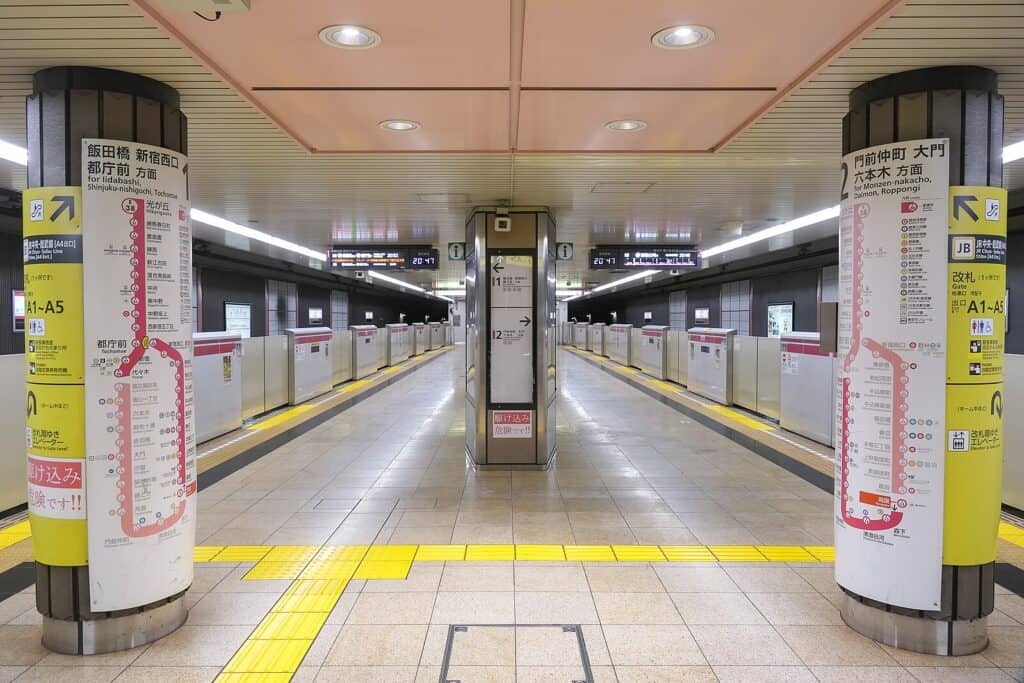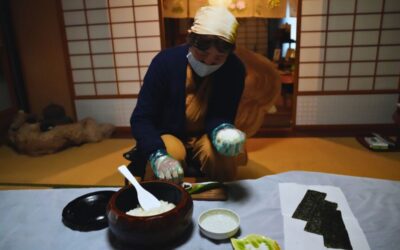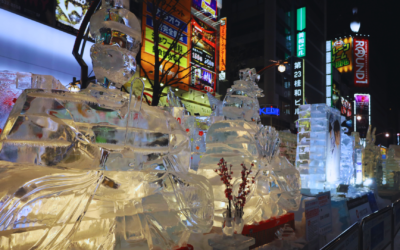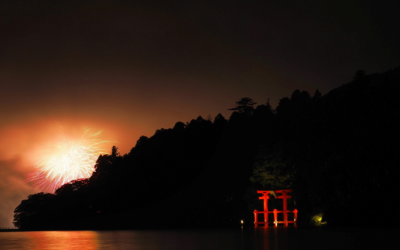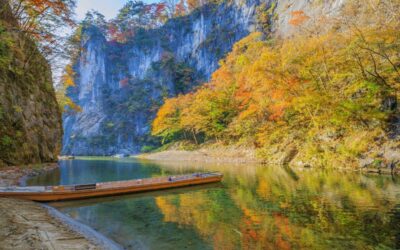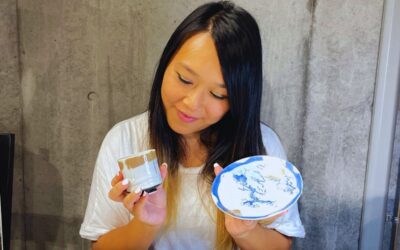Tokyo is a city of endless exploration, and one of the best ways to experience its contemporary allure is by hopping on the Oedo Line. This modern subway line is distinguished by its deep underground routes, sleek maroon and silver trains, and advanced technology. The Oedo Line forms a large loop through central Tokyo, connecting vibrant districts such as Shinjuku, Roppongi, and Tsukiji, and extending to quieter residential areas and business hubs. Opened in 1991 and fully completed in 2000, it is one of the newest additions to Tokyo’s extensive subway network.
The Oedo Line is known for its efficiency and convenience, making it a popular choice for a wide range of passengers. Business professionals rely on it for its punctuality and coverage of key commercial districts. Tourists appreciate the line for its accessibility to major attractions and the clear, multilingual signage that guides them through the bustling city. Local residents use it for its connectivity to residential areas and the seamless transfers it offers to other lines.

The trains themselves are designed with comfort and modernity in mind. They are equipped with advanced safety features, priority seating for the elderly and disabled, and clear electronic displays that provide real-time information in both Japanese and English. The stations are equally impressive, often featuring contemporary art and architecture that reflect the character of the neighbourhoods they serve.
This itinerary will take you through three vibrant stops on the Oedo Line. Starting in the lively, neon-lit streets and lush gardens of Shinjuku, we’ll move to the international flair and cultural richness of Roppongi, before reaching the dynamic market atmosphere of Tsukiji. Each stop showcases the modern and eclectic spirit of Tokyo, making for an unforgettable day of contemporary exploration in the city.
Oedo Line Stop 1: Shinjuku
Visit Shinjuku Gyoen National Garden
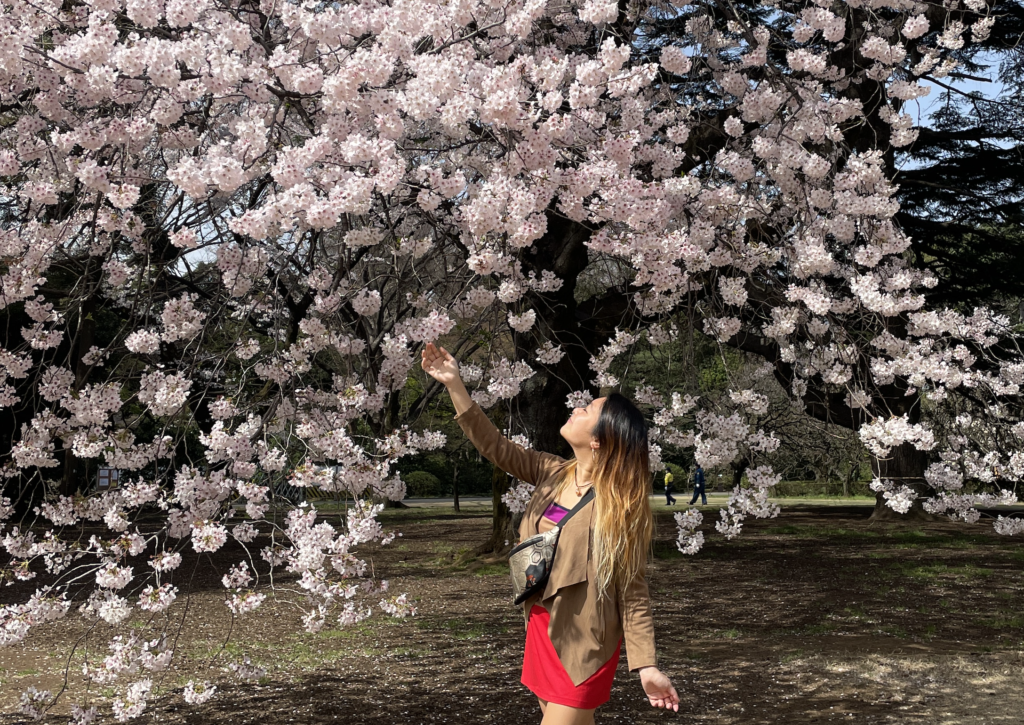
Start your adventure in Shinjuku, one of Tokyo’s most bustling districts. Upon arriving at Shinjuku Station, follow the signs to Exit C1, which is the most convenient exit for reaching Shinjuku Gyoen National Garden. From Exit C1, it’s about a 10-minute walk to the garden’s Shinjuku Gate.
Shinjuku Gyoen National Garden spans 58.3 hectares and features three distinct styles of landscape architecture: traditional Japanese, English, and French gardens. The park is structured with wide, open lawns, meandering pathways, and beautifully landscaped areas, making it an ideal spot for a leisurely stroll.
Seasonal Highlights:
- Spring: Visit the Japanese garden to witness the cherry blossoms in full bloom. The garden boasts over 1,000 cherry trees, making it one of Tokyo’s prime hanami (cherry blossom viewing) spots. Early April is the peak season, but different varieties of cherry trees ensure blooms from late March to early May.
- Summer: The English landscape garden, with its expansive lawns and vibrant flowerbeds, is particularly beautiful in summer. The French formal garden also showcases meticulously arranged roses that reach their peak in late May and early June.
- Autumn: The Japanese garden transforms with stunning autumn foliage. Late November to early December is the best time to see the vivid reds and oranges of the maple trees. The chrysanthemums in the traditional Japanese garden are another highlight.
- Winter: While the gardens are less colorful, the serene atmosphere and occasional snowfall provide a peaceful retreat. The greenhouse, featuring tropical and subtropical plants, offers a warm escape from the winter chill.
Garden Features:
- Japanese Traditional Garden: This area includes a large pond, teahouses, and pavilions. It’s an excellent spot for experiencing a traditional Japanese landscape with seasonal flowers and meticulously pruned trees.
- English Landscape Garden: Characterized by its large, open lawns and naturalistic plantings, this area is perfect for picnics and relaxation.
- French Formal Garden: Known for its symmetrical layout and beautifully manicured flowerbeds, this area is particularly stunning in spring and summer.
The entrance fee is around 500 yen, making it a budget-friendly start to your day. Plan to spend about 1-2 hours strolling through the meticulously maintained gardens, enjoying the seasonal flowers and peaceful atmosphere. Don’t forget to visit the greenhouse near the Okido Gate, which houses a variety of tropical and subtropical plants. There are also several teahouses within the garden where you can enjoy a quiet moment and traditional Japanese tea.
Shopping at Lumine or Isetan Department Store
Next, relax and engage in some retail therapy. Head to Lumine or Isetan Department Store for a comprehensive shopping experience.
Lumine
Lumine is located directly above Shinjuku Station. Lumine is split into two main buildings: Lumine 1 and Lumine 2, connected by an overpass. From Shinjuku Station, take the South Exit to access Lumine 1. To get to Lumine 2, use the overpass connecting the two buildings. Here’s how to navigate your visit:
- Lumine 1: This building houses a variety of fashion and lifestyle brands catering to a younger, trend-conscious crowd. Popular stores include Beams for stylish casual wear, Urban Research for trendy apparel, and Cosme Kitchen for organic beauty products. For dining, head to the top floors where you can find cafes like Afternoon Tea Room, which offers delightful pastries and tea sets. Visit Lumine 1 Website.
- Lumine 2: Connected by an overpass to Lumine 1, this building offers more fashion stores and a wider range of lifestyle products. Check out Journal Standard for high-quality, casual clothing, or Francfranc for chic home decor and accessories. The restaurant floors offer a variety of cuisines, making it a great place to grab a meal. Visit Lumine 2 Website.
Isetan
For a more luxurious shopping experience, visit Isetan. From Shinjuku Station, take the East Exit. It’s a 5-minute walk to Isetan. Follow the signs or use Google Maps to ensure you stay on track.
Here’s how to navigate your visit:
- Fashion and Luxury Goods: Isetan is renowned for its high-end selection of goods, including designer fashion brands like Gucci, Chanel, and Louis Vuitton. For contemporary fashion, check out the floors dedicated to women’s and men’s wear, where you can find exclusive pieces and the latest collections. Visit Isetan Website.
- Gourmet Food Hall: The basement food hall, known as Depachika, offers a wide array of delicacies, from sushi and sashimi to French patisserie. Make sure to try the exquisite bento boxes, freshly made sushi from the live counters, and beautifully crafted wagashi (Japanese sweets). The cheese and wine sections are also top-notch, offering a vast selection of premium products.
- Home and Living: For unique home goods, explore the upper floors where you can find premium kitchenware, elegant table settings, and luxurious bedding. The store also features exclusive items from Japanese artisans, perfect for souvenirs or gifts.
Whether you’re window shopping or hunting for a special purchase, Lumine and Isetan cater to all tastes and budgets, making Shinjuku a shopper’s paradise.
Explore Omoide Yokocho for Traditional Food
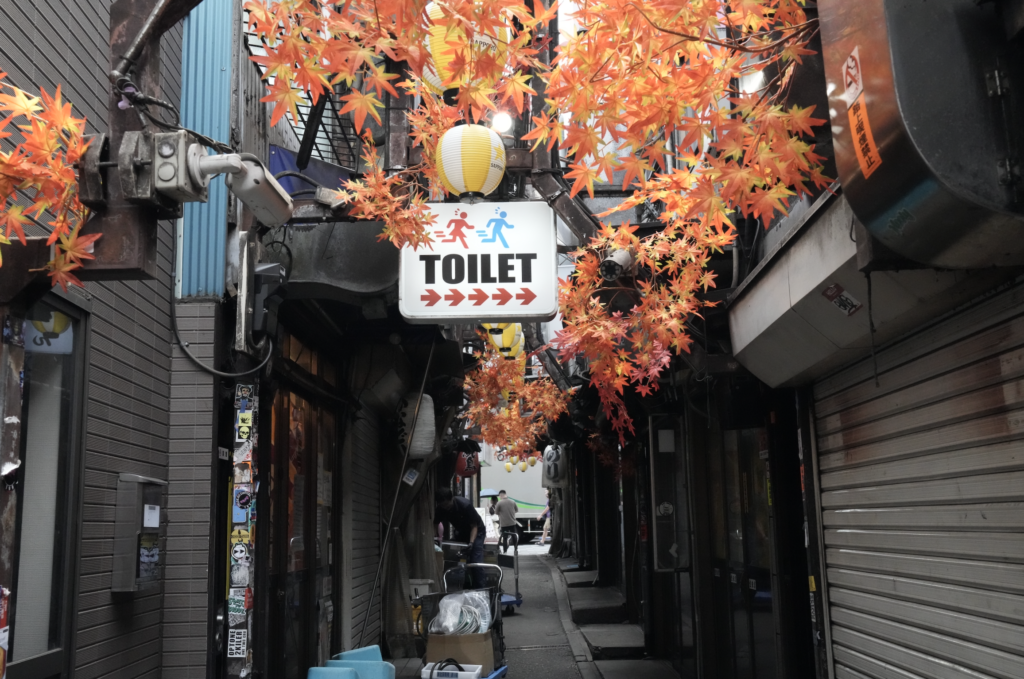
Exhausted (but definitely satisfied!) from the shopping and park stroll, round off your Shinjuku adventure with some culinary heritage at Omoide Yokocho, also known as “Memory Lane.”
To get there, return to Shinjuku Station and take Exit B16. Once you exit, head west towards the Odakyu Department Store. Omoide Yokocho is situated on the right side, just a short 5-minute walk from the station. If you get lost, simply follow the aroma of grilled food that fills the air.
Dining Recommendations:
- Tsunahachi: Famous for its tempura, Tsunahachi offers a variety of tempura dishes, including shrimp, fish, and seasonal vegetables, all lightly battered and fried to perfection. Prices range from 1000-2000 yen. Don’t miss their tempura set meals, which come with rice, miso soup, and pickles.
- Torishige: Well-known for its yakitori, Torishige serves succulent grilled chicken skewers seasoned with a choice of tare (sweet soy sauce) or shio (salt). A meal here typically costs between 800-1500 yen. Try their special chicken liver yakitori, which is a local favourite.
- Shinjuku Kappo Nakajima: For a taste of traditional Japanese home-style cooking, visit Nakajima, which offers dishes like sardine sashimi and grilled fish. Meals here are reasonably priced, typically costing around 1000-1500 yen for a set meal.
Omoide Yokocho offers a nostalgic atmosphere, with its narrow lanes, paper lanterns, and tiny establishments each accommodating a handful of diners. The ambiance takes you back to post-war Japan, making it a unique dining experience. Plan to spend about 1-2 hours here, allowing enough time to enjoy your meal and soak in the lively, historic surroundings.
Each establishment provides a cosy and authentic dining experience, with friendly staff and a welcoming atmosphere. It’s an ideal spot for both solo travellers and small groups looking to enjoy traditional Japanese cuisine in an intimate setting.
Oedo Line Stop 2: Roppongi
Art Viewing at Roppongi Hills and the Mori Art Museum
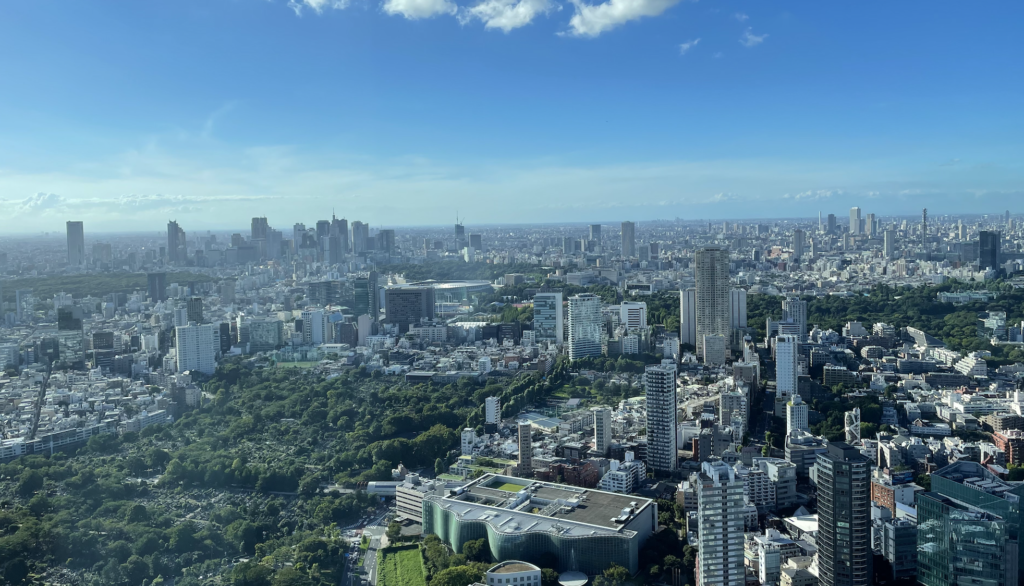
After exploring Omoide Yokocho, head back to Shinjuku Station and take the Oedo Line towards Roppongi. Board the train on Platform 3. The ride to Roppongi takes about 15 minutes and covers six stops, with a fare of approximately 220 yen. Upon arrival at Roppongi Station, use Exit 1C for direct access to Roppongi Hills.
Begin your exploration at Roppongi Hills, a vibrant complex featuring shops, restaurants, and the renowned Mori Art Museum. The museum hosts rotating exhibitions of contemporary art from Japan and around the world. Admission fees vary by exhibition but are generally around 1800 yen. Plan to spend about 1-2 hours here, taking in the latest exhibitions and enjoying panoramic views of Tokyo from the museum’s observation deck. Notable past exhibitions include the works of Takashi Murakami and Yayoi Kusama, which have attracted art enthusiasts from around the globe.
Visit Tokyo Midtown and Its Design Shops
After your art tour, take a short walk to Tokyo Midtown, another key cultural and commercial complex in Roppongi. From Roppongi Hills, walk east along Roppongi Dori Avenue for about 10 minutes until you reach Tokyo Midtown. Tokyo Midtown is home to several design and lifestyle stores, including Muji and IDEE Shop, where you can find unique home goods and stylish furnishings.
- Muji: Known for its minimalist design, Muji offers a range of household goods, clothing, and snacks at reasonable prices. Recommended purchases include their stackable storage units, sleek kitchenware, and high-quality organic cotton clothing. Their travel accessories, such as packing cubes and neck pillows, are also popular for their practicality and design. Visit Muji Website.
- Samantha Thavasa: A popular Japanese brand known for its stylish handbags and accessories. The shop offers a variety of fashionable and functional bags that make for great souvenirs or gifts.
- Plaza: This store offers a variety of trendy cosmetics, unique stationery, and fun snacks that are perfect for tourists. Plaza is a great place to find cute Japanese products and gifts to take home.
The complex also features beautiful outdoor spaces and art installations, providing a pleasant backdrop for a leisurely afternoon stroll. Previous installations at Tokyo Midtown have included works by renowned artists like Yayoi Kusama and teamLab, which have captivated visitors with their innovative and interactive designs.
Optional Activities
- Suntory Museum of Art: Located within Tokyo Midtown, this museum often features exhibitions on traditional Japanese art and crafts. Admission fees vary, but it’s typically around 1300 yen. Past exhibitions have included “The Art of Zen: From Mind to Form” and displays of Edo-period ceramics. These exhibits offer a fascinating glimpse into Japan’s rich cultural heritage. Visit Suntory Museum of Art Website.
- 21_21 Design Sight: Also in Tokyo Midtown, this design museum focuses on innovative and contemporary design works. Admission is usually around 1200 yen. Notable past exhibitions include “Chocolate” by designer Naoto Fukasawa, which explored the sensory experience of chocolate, and “Athlete,” which examined the intersection of sports and design. Visit 21_21 Design Sight Website.
Oedo Line Stop 3: Tsukiji
Walk Through the Outer Tsukiji Fish Market
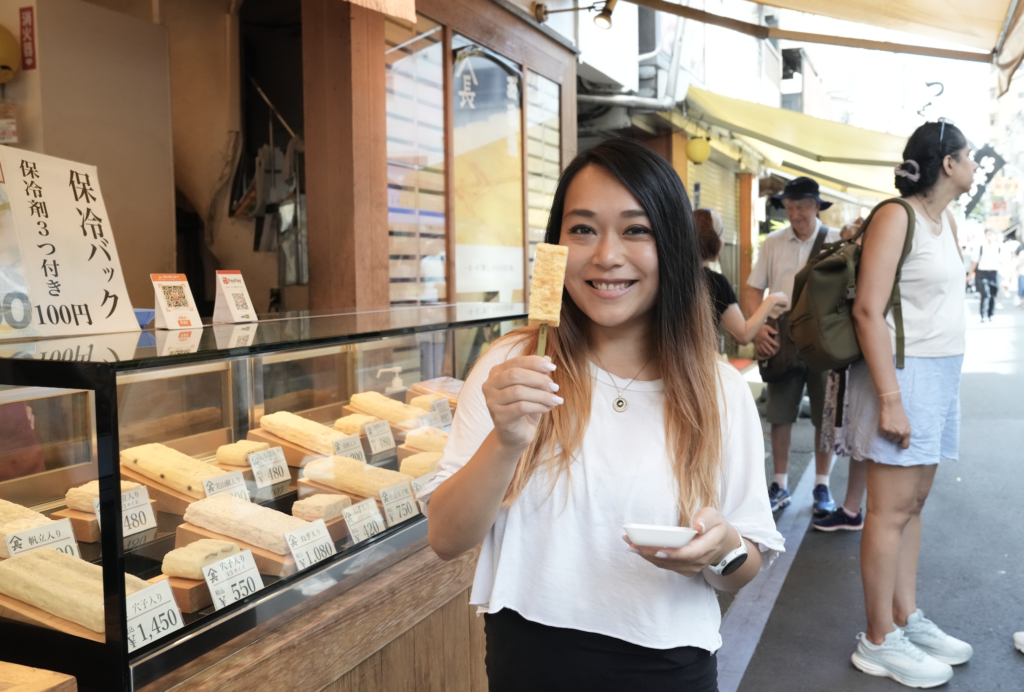
Finish your Oedo Line journey at Tsukiji, famous for its historic fish market. To get there, take the Oedo Line from Roppongi Station to Tsukiji-Shijo Station. Board the train on Platform 1. The ride takes about 12 minutes and covers five stops, with a fare of approximately 220 yen. Upon arrival, use Exit A1 for the most convenient access to the outer market.
Although the inner wholesale market has moved to Toyosu, the outer Tsukiji Fish Market remains vibrant with numerous stalls and shops selling fresh seafood, produce, and other local specialties. Wander through the bustling alleys to sample a variety of street foods, such as tamagoyaki (Japanese omelette), grilled scallops, and sushi rolls. Popular stalls to visit include:
- Marutake: Famous for its delicious tamagoyaki, Marutake offers both sweet and savoury versions. The sweet version is lightly sweetened, while the savoury version includes a hint of dashi (Japanese soup stock). Prices typically range from 100-200 yen per piece. For a heartier snack, try the tamagoyaki sandwich, which costs around 300 yen. Marutake is located along Namiyoke Street, easily recognizable by the aroma of freshly cooked omelettes.
- Tsukiji Saito Fisheries: Known for their fresh and grilled seafood, particularly scallops and oysters. Grilled scallops, served with a touch of soy sauce and butter, cost around 500-800 yen each, depending on size. The fresh oysters are priced at about 300-600 yen each and are a must-try for seafood lovers. Tsukiji Saito Fisheries is situated in the heart of the market, often with a line of eager customers.
Allow about 1-2 hours to explore the market, taste different foods, and pick up some souvenirs like dried seaweed, green tea, or unique kitchen utensils.
Try Fresh Sushi at One of the Local Eateries

A visit to Tsukiji wouldn’t be complete without tasting some of the freshest sushi in Tokyo. Many small eateries and sushi counters in the area serve up delicious sushi at reasonable prices, with meals generally costing between 1500-3000 yen. Recommended spots include:
- Sushidai: Known for its fresh and high-quality sushi, Sushidai offers a variety of sushi sets that highlight the best seasonal ingredients. A popular choice is the Omakase set, which includes 10 pieces of sushi and a roll for around 3500 yen. Expect to queue, as it’s quite popular. The restaurant is located on the outer market’s edge, making it easy to find.
- Sushi Zanmai: A well-known chain that offers excellent sushi at reasonable prices. Their tuna selections, particularly the Otoro (fatty tuna), are famous. A sushi set here typically costs between 2000-4000 yen, depending on the selection. Sushi Zanmai has several locations around the market, with the main branch being the most popular.
Plan to spend about an hour enjoying your meal. It’s the perfect opportunity to savour authentic Japanese cuisine in a historic setting.
Alternatively, Visit Tsukiji Uogashi Building
Tsukiji Uogashi Building is a contemporary facility dedicated to preserving the market’s vibrant culture in a modern setting. Located just a short walk from the Tsukiji Fish Market, this building offers various fresh seafood, cooking demonstrations, and culinary workshops.
From Tsukiji Outer Market, walk east along Harumi Street for about 5 minutes to reach the Tsukiji Uogashi Building. The building features two floors of market stalls where vendors sell high-quality seafood and related products. On the upper floors, you’ll find restaurants offering modern takes on traditional dishes. There are also cooking classes available for those interested in learning how to prepare Japanese seafood delicacies.
Prices for fresh seafood vary, but expect to pay around 1000-2000 yen for a good selection. Cooking classes and demonstrations typically cost between 3000-5000 yen, depending on the course.
Explore Tsukiji Hongan-ji Temple
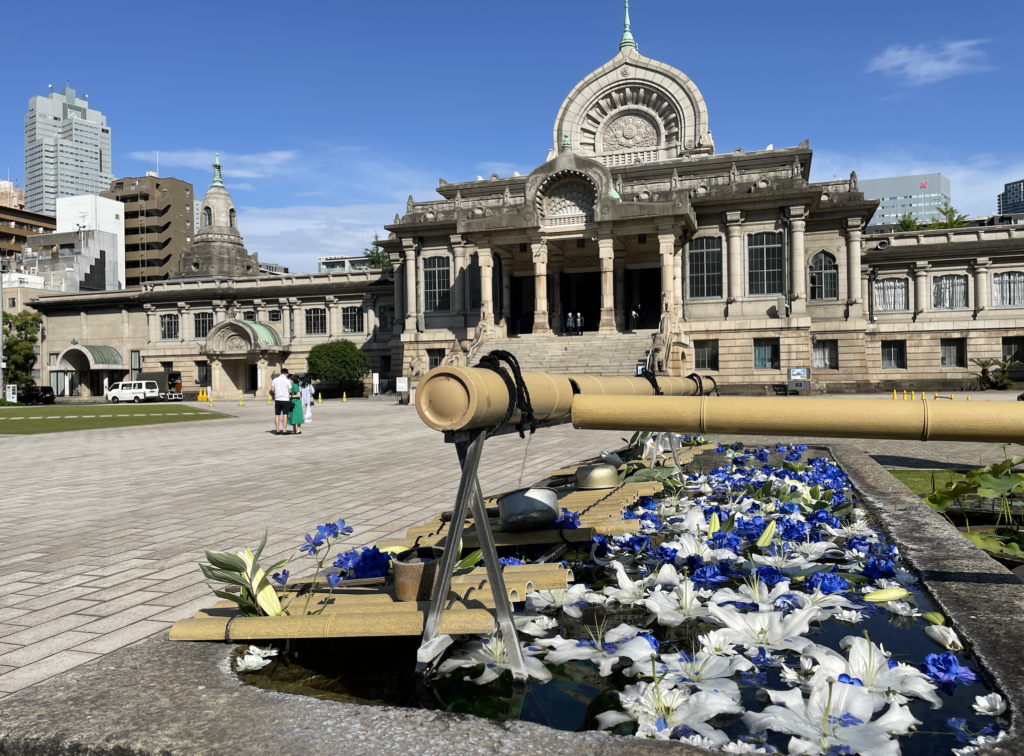
Conclude your visit with a stop at Tsukiji Hongan-ji Temple, located just a short 5-minute walk from the market. This Buddhist temple, with its unique architectural style inspired by South Asian temples, offers a peaceful retreat and a glimpse into Japan’s spiritual heritage. The temple’s main hall features intricate carvings and a serene interior ideal for quiet reflection.
From the outer market, head northwest along Shin-Ohashi Dori Avenue. The temple is hard to miss with its distinctive Indian-inspired architecture. Entry to the temple is free, making it an accessible and enriching experience for all visitors.
Spend around 30 minutes to an hour exploring the temple grounds, admiring the architecture, and perhaps participating in a meditation session if one is available. The temple also hosts occasional cultural events and ceremonies, which can provide deeper insights into Buddhist practices in Japan.
Experience the Modern Wonders of Tokyo on the Oedo Line
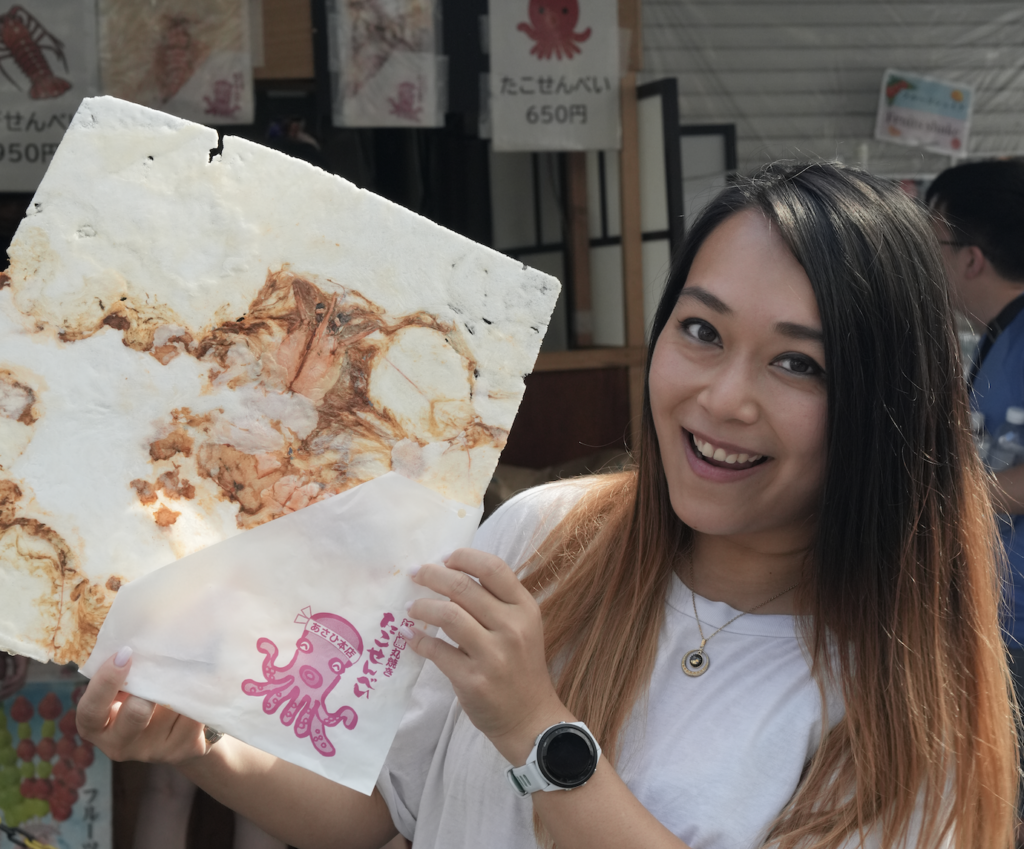
The Oedo Line provides a seamless connection through some of Tokyo’s most exciting neighbourhoods. From the serene gardens and bustling food streets of Shinjuku to the art and international cuisine in Roppongi, and the historic market vibes of Tsukiji, each stop offers a unique slice of Tokyo life. Exploring lush parks, indulging in gourmet meals, and navigating vibrant markets, the Oedo Line ensures a rich and varied journey through the heart of Tokyo.
As a first-time visitor or a seasoned traveller, the Oedo Line is your gateway to discovering the modern wonders of this incredible city. Each stop presents an opportunity to experience the diverse and dynamic spirit of Tokyo. Hop on the Oedo Line and immerse yourself in the vibrant culture, cutting-edge art, and culinary delights that Tokyo has to offer.
Want local Japan experts to plan your trip for you? Look no further than Flip Japan Guide Travel Planner. Whether you want us to organize your trip by train line, by personal interest, or whatever else—we’ve got you covered. Reach out now and start planning your Japan adventure!

